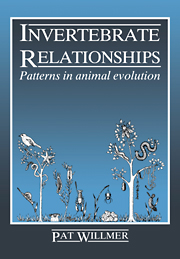Book contents
- Frontmatter
- Contents
- Acknowledgements
- Part I Introduction to animal phylogeny
- Part II Sources of evidence in invertebrate phylogeny
- 3 Evidence from the fossil record
- 4 Evidence from chemistry and genetics
- 5 Evidence from embryology and larvae
- 6 Evidence from cell ultrastructure
- Part III Phylogeny of major groups
- References
- Index
6 - Evidence from cell ultrastructure
Published online by Cambridge University Press: 08 January 2010
- Frontmatter
- Contents
- Acknowledgements
- Part I Introduction to animal phylogeny
- Part II Sources of evidence in invertebrate phylogeny
- 3 Evidence from the fossil record
- 4 Evidence from chemistry and genetics
- 5 Evidence from embryology and larvae
- 6 Evidence from cell ultrastructure
- Part III Phylogeny of major groups
- References
- Index
Summary
Introduction
Any biological phenomenon must be dependent upon the fundamental activities of cells. Most obviously, cellular differentiation gives rise to the structural features of tissues and organs, and thus to the overall embryology and morphology of organisms that have been the classic materials for phylogenetic studies. In addition, short-term changes in cell structure and behaviour often initiate physiological or mechanical processes affecting the whole animal, influencing its relations with its environment and the selective pressures it experiences. Hence comparative studies of cells themselves should obviously have some role in an analysis of invertebrate relationships.
Some aspects of cell behaviour were considered in the previous two chapters. Virtually all the chemical constituents of the animal (chapter 4) are cellular products, either within the cell membrane or as secretions from it. And the processes of differentiation of embryos (chapter 5), from cell fusion at fertilisation through all stages of ontogenesis, are major cell behaviour phenomena. But now the concern is rather with cell structure and its bearing on phylogenetic matters. This has been an area of growing importance in the last fifteen years, with a literature largely derived from European sources in general and German authors in particular. An appreciation of some of the more important topics by English–speaking audiences has been lacking until very recently.
Clearly comparisons of cell structure rely on different techniques from earlier morphological studies, and have therefore only been possible since electron microscopes became available in the 1950s. Their increasing prevalence has led to the period since 1970 being termed the ‘era of ultrastructure’.
- Type
- Chapter
- Information
- Invertebrate RelationshipsPatterns in Animal Evolution, pp. 131 - 160Publisher: Cambridge University PressPrint publication year: 1990



